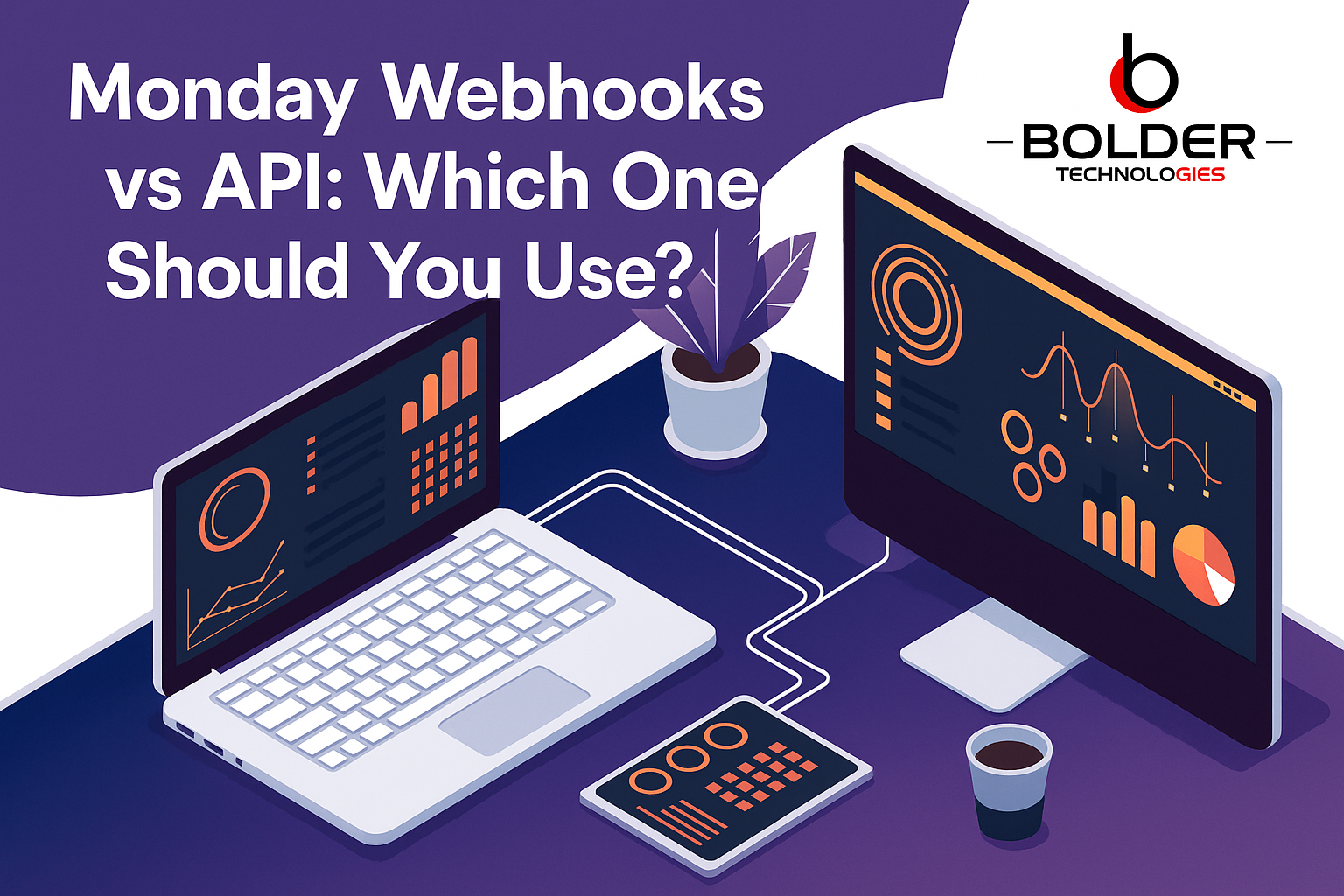Monday.com is a popular tool for managing projects, tasks, and team workflows. It works well out of the box, but you can get even more out of it with automation. Two powerful options for automating Monday are APIs and webhooks.
Both tools help you connect Monday with other systems. But they work differently. One pulls or pushes data. The other waits for something to happen and responds instantly. In this blog, we’ll explore monday webhooks vs api, how they work, and when to use each one. We’ll also share some examples and tips that anyone can understand and apply.
What Is a Monday API?
The Monday API lets different apps talk to each other. It allows you to get data from Monday or send updates into your boards. You can use it to create tasks, change statuses, assign people, or pull reports.
Think of it like a waiter taking your order. You ask the system for something, and it brings it to you. With the monday automation api, you’re in full control. You choose what to send, what to change, and when to do it.
APIs are useful when you need to interact with your data directly. You tell the system what to do, and it follows those instructions exactly.
What Is a Webhook?
A webhook is like a silent watcher. It listens for a change, and then sends that update to another system. You don’t have to ask it to check. It reacts the moment something changes.
With monday.com webhooks, you can set up rules that trigger when something happens. For example, when a task is marked as “Done,” a webhook can send a message to another app, like Slack or Gmail.
Unlike APIs, webhooks don’t request anything. They simply respond to monday trigger events. This makes them fast and perfect for instant updates. It’s like a doorbell that rings the moment someone presses it.
Monday Webhooks vs API: What’s the Difference?
Both APIs and webhooks are used to automate workflows and move data between systems. But they are not the same. Each tool has its strengths, and they serve different needs.
The monday data push api lets you request, change, or create data when needed. You decide when to use it. It works well when you need control over your data and want to run reports, create dashboards, or manage tasks across tools.
Monday.com webhooks, on the other hand, work automatically. They wait for something to happen and then push the data. They’re perfect for sending quick alerts or starting an action when a task changes.
So when comparing monday webhooks vs api, the choice depends on how and when you want to interact with your data.
Use Case: When to Use Monday API
Let’s say your team collects customer feedback through a website form. You want that data to appear in Monday as a new item. You also want to assign it to someone and give it a due date.
With the API, you can automate that entire process. As soon as the form is filled, the API pulls the data, creates a task, and fills all the needed columns.
This is just one of many ways the API helps with monday automation api tasks. It gives you flexibility, logic, and control. If you want to manage your data fully, APIs are the way to go.
Use Case: When to Use Monday Webhooks
Imagine you’re running a project where task deadlines are very important. You want to notify your team every time a task status is changed to “Overdue.” But you don’t want to keep checking the board manually.
This is where monday.com webhooks shine. You set a webhook to trigger when the status changes to “Overdue.” It then sends a message or alert to your team via email or Slack.
Webhooks are great for live reactions to monday trigger events. They are fast, simple to set up, and ideal when you only need to respond to one specific event.
Can You Use Both Together?
Yes, and many advanced teams do. APIs and webhooks can work together to build a powerful system that responds quickly and handles complex tasks.
Let’s say a webhook triggers when a new task is created. It then sends that event to your app. Your app can use the monday data push api to pull more details or assign the task to the right person.
By using both, you get the speed of webhooks and the control of APIs. You can respond in real time and still apply logic or filters to your actions. This combo creates more flexible and reliable automations.
Things to Keep in Mind
When working with webhooks or APIs, it’s important to follow best practices. These steps will keep your setup fast, safe, and clean.
- Always test your system on a sample board before going live.
- Store your API tokens safely and don’t expose them in public code.
- Use rate limits wisely. Too many API calls can slow things down.
- Avoid setting too many webhooks on the same event to prevent overload.
- Follow the official guidelines in Monday’s developer documentation.
Using a clear structure and reviewing your setup regularly will improve performance. It also helps you avoid future errors or conflicts.
Which One Should You Use?
Choose the API when you want full control. It’s best for managing items, building reports, or syncing data with other systems. The API gives you power to request exactly what you need, when you need it.
Choose webhooks when you want to act fast. They’re perfect for simple, instant reactions to task changes or updates. They use fewer resources and respond automatically.
In many cases, the best option is to use both. Let webhooks detect changes and use APIs to decide what happens next. This gives you the best mix of speed and flexibility.
Conclusion
Both webhooks and APIs are useful tools for automation in Monday.com. APIs give you full control over your data. Webhooks give you speed and instant reaction. Each has its place depending on your needs.
If you want to create a fast, smart system, it’s worth using both together. Knowing when to use them and how to use them well will help you save time and build better workflows.
Need help deciding between monday webhooks vs api? Bolder Technologies can guide you through smart automation. We build solutions using monday.com webhooks, APIs, and the best of both. Let’s create something powerful, together.
Need Help Integrating APIs?
Let us handle the tech so you can focus on growing your business.
🚀 Book a Free Consultation
